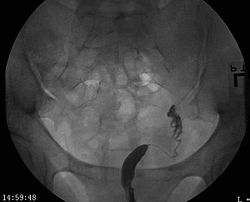Unicornuate uterus

Editor-In-Chief: Prab R Tumpati, MD
Obesity, Sleep & Internal medicine
Founder, WikiMD Wellnesspedia &
W8MD medical weight loss NYC and sleep center NYC
| Unicornuate uterus | |
|---|---|

| |
| Synonyms | Uterus unicornis |
| Pronounce | N/A |
| Specialty | N/A |
| Symptoms | Pelvic pain, infertility, recurrent pregnancy loss |
| Complications | Ectopic pregnancy, preterm birth, miscarriage |
| Onset | Congenital |
| Duration | Lifelong |
| Types | N/A |
| Causes | Müllerian duct anomaly |
| Risks | Endometriosis, renal agenesis |
| Diagnosis | Ultrasound, MRI, hysterosalpingography |
| Differential diagnosis | Bicornuate uterus, septate uterus, didelphic uterus |
| Prevention | N/A |
| Treatment | Surgical intervention, assisted reproductive technology |
| Medication | N/A |
| Prognosis | Variable, depending on associated conditions |
| Frequency | 1 in 4,000 women |
| Deaths | N/A |
A type of congenital uterine anomaly

A unicornuate uterus is a type of congenital disorder of the female reproductive system where the uterus is formed from only one Mullerian duct. This results in a uterus that is smaller than normal and has a single fallopian tube.
Development[edit]
The unicornuate uterus occurs due to the incomplete development of one of the paired Mullerian ducts during embryogenesis. Normally, the two ducts fuse to form a single uterine cavity, but in the case of a unicornuate uterus, one duct fails to develop or is underdeveloped, leading to a hemi-uterus.
Classification[edit]
Unicornuate uteri are classified based on the presence or absence of a rudimentary horn, which may or may not communicate with the main uterine cavity. The classification includes:
- Unicornuate uterus with a communicating rudimentary horn
- Unicornuate uterus with a non-communicating rudimentary horn
- Unicornuate uterus with no rudimentary horn
- Unicornuate uterus with a rudimentary horn containing no cavity
Symptoms and Diagnosis[edit]
Women with a unicornuate uterus may experience dysmenorrhea, infertility, or recurrent miscarriage. Diagnosis is typically made through imaging techniques such as ultrasound, MRI, or hysterosalpingography.
Complications[edit]
The presence of a unicornuate uterus can lead to several complications, particularly during pregnancy. These include:
- Increased risk of ectopic pregnancy
- Preterm birth
- Intrauterine growth restriction
- Breech presentation
Treatment[edit]
There is no treatment to correct the anatomical anomaly of a unicornuate uterus. However, management focuses on addressing symptoms and complications. In some cases, surgical removal of a rudimentary horn may be necessary if it causes pain or other issues.
Prognosis[edit]
The reproductive prognosis for women with a unicornuate uterus varies. While some women may experience normal pregnancies, others may face challenges such as infertility or recurrent pregnancy loss. Close monitoring by healthcare providers is often recommended during pregnancy.
See also[edit]
References[edit]
<references group="" responsive="1"></references>
Ad. Transform your life with W8MD's Budget GLP-1 injections from $75


W8MD offers a medical weight loss program to lose weight in Philadelphia. Our physician-supervised medical weight loss provides:
- Weight loss injections in NYC (generic and brand names):
- Zepbound / Mounjaro, Wegovy / Ozempic, Saxenda
- Most insurances accepted or discounted self-pay rates. We will obtain insurance prior authorizations if needed.
- Generic GLP1 weight loss injections from $75 for the starting dose.
- Also offer prescription weight loss medications including Phentermine, Qsymia, Diethylpropion, Contrave etc.
NYC weight loss doctor appointmentsNYC weight loss doctor appointments
Start your NYC weight loss journey today at our NYC medical weight loss and Philadelphia medical weight loss clinics.
- Call 718-946-5500 to lose weight in NYC or for medical weight loss in Philadelphia 215-676-2334.
- Tags:NYC medical weight loss, Philadelphia lose weight Zepbound NYC, Budget GLP1 weight loss injections, Wegovy Philadelphia, Wegovy NYC, Philadelphia medical weight loss, Brookly weight loss and Wegovy NYC
|
WikiMD's Wellness Encyclopedia |
| Let Food Be Thy Medicine Medicine Thy Food - Hippocrates |
Medical Disclaimer: WikiMD is not a substitute for professional medical advice. The information on WikiMD is provided as an information resource only, may be incorrect, outdated or misleading, and is not to be used or relied on for any diagnostic or treatment purposes. Please consult your health care provider before making any healthcare decisions or for guidance about a specific medical condition. WikiMD expressly disclaims responsibility, and shall have no liability, for any damages, loss, injury, or liability whatsoever suffered as a result of your reliance on the information contained in this site. By visiting this site you agree to the foregoing terms and conditions, which may from time to time be changed or supplemented by WikiMD. If you do not agree to the foregoing terms and conditions, you should not enter or use this site. See full disclaimer.
Credits:Most images are courtesy of Wikimedia commons, and templates, categories Wikipedia, licensed under CC BY SA or similar.
Translate this page: - East Asian
中文,
日本,
한국어,
South Asian
हिन्दी,
தமிழ்,
తెలుగు,
Urdu,
ಕನ್ನಡ,
Southeast Asian
Indonesian,
Vietnamese,
Thai,
မြန်မာဘာသာ,
বাংলা
European
español,
Deutsch,
français,
Greek,
português do Brasil,
polski,
română,
русский,
Nederlands,
norsk,
svenska,
suomi,
Italian
Middle Eastern & African
عربى,
Turkish,
Persian,
Hebrew,
Afrikaans,
isiZulu,
Kiswahili,
Other
Bulgarian,
Hungarian,
Czech,
Swedish,
മലയാളം,
मराठी,
ਪੰਜਾਬੀ,
ગુજરાતી,
Portuguese,
Ukrainian